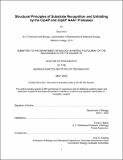Structural Principles of Substrate Recognition and Unfolding by the ClpAP and ClpXP AAA+ Proteases
Author(s)
Kim, Sora
DownloadThesis PDF (23.08Mb)
Advisor
Baker, Tania A.
Terms of use
Metadata
Show full item recordAbstract
Protein degradation is a key regulatory mechanism that controls protein homeostasis in all cells. Found in all domains of life, proteases of the AAA+ (ATPases associated with diverse cellular activities) superfamily perform targeted protein degradation of specific substrates. All AAA+ proteases consist of a hexameric AAA+ unfoldase and a compartmentalized peptidase. AAA+ proteases harness the energy of ATP hydrolysis to mechanically unfold and translocate substrates through the axial channel into the peptidase chamber for degradation. Degradation by AAA+ proteases is carefully regulated by several mechanisms, including selective recognition of specific peptide sequences in the substrate (called degrons), substrate-tethering sequences (called enhancement- or e-tags), and adaptor proteins.
My thesis examines the structural basis of substrate recognition and degradation by the bacterial AAA+ proteases ClpAP and ClpXP, which are composed of either the double-ringed ClpA or the single-ring ClpX unfoldase in complex with the ClpP peptidase. Using covalently crosslinked ClpA–ClpP complexes, I interrogate the symmetry mismatch between the ClpA hexamer and the ClpP heptamer interface to establish that rotation of ClpA relative to ClpP is not required for proteolytic function, contrary to the prediction of structure-based models. Next, I present cryo-EM structures of ClpAP in complex with its adaptor ClpS and an N-degron substrate, revealing the degron-like binding of the ClpS NTE in the ClpA channel and an altered, ‘tucked’ pore-1-loop conformation. I also investigate the function of ClpA D1 pore 2 loops in adaptor-independent and ClpS-assisted degradation. Next, using engineered fusion proteins, I show that a Pro-Pro dipeptide (found in the ClpS junction) near a folded domain is sufficient for protection from ClpAP. Finally, I investigate the redox-sensitive mechanism of ClpXP degradation of the bacterial global transcription regulator FNR and demonstrate that the N terminal e-tag is a ClpX-tethering motif and the C-terminal recognition signal is a pore-binding tag. Crystal structures of apo (oxidized) and [4Fe-4S] bound holoFNR reveal how oxygen-induced conformational changes alter exposure of these two signals to selectively target the apo form for degradation. In summary, these studies identify distinct elements within enzymes, adaptors, and substrates that contribute specific functions during the multistep process of degradation by AAA+ proteases.
Date issued
2022-05Department
Massachusetts Institute of Technology. Department of BiologyPublisher
Massachusetts Institute of Technology